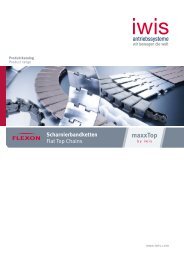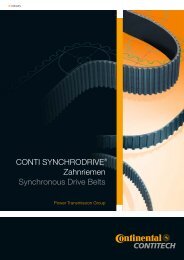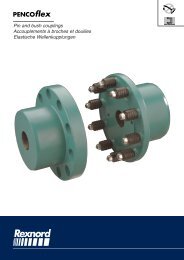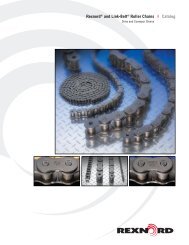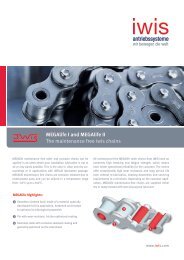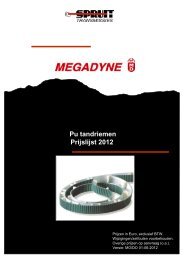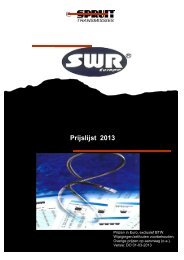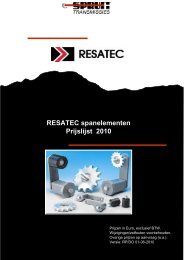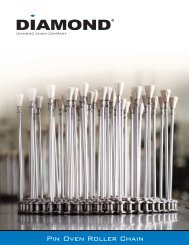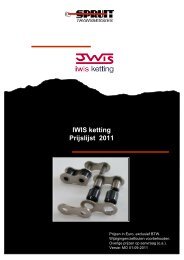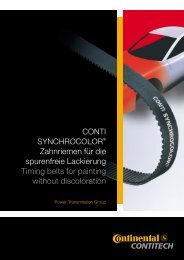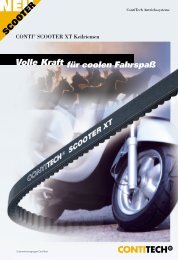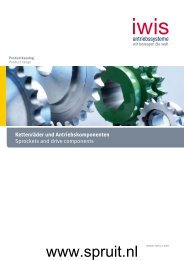und Förderketten High-performance roller and conveyor chains
und Förderketten High-performance roller and conveyor chains
und Förderketten High-performance roller and conveyor chains
You also want an ePaper? Increase the reach of your titles
YUMPU automatically turns print PDFs into web optimized ePapers that Google loves.
iwis Customer Service<br />
Tel: +49 2739 86-0 Fax: -22 CallBack<br />
E-Mail: sales-wilnsdorf@iwis.com<br />
1<br />
2<br />
Flyerketten<br />
Leaf <strong>chains</strong><br />
7<br />
ELITE-Flyerketten werden überall dort eingesetzt, wo Lasten gehoben<br />
oder gezogen werden <strong>und</strong> wo es demzufolge auf hohe<br />
Bruchkräfte ankommt. Die weiteste Verwendung finden ELITE-<br />
Flyerketten in Hubmasten von Gabelstaplern, aber auch als<br />
Gegengewichtsketten bei Werkzeugmaschinen, als Ziehbankketten<br />
oder in Containerhubwagen werden sie eingesetzt.<br />
Im Gegensatz zu Rollenketten bestehen Flyerketten nur aus Bolzen<br />
<strong>und</strong> Laschen, wodurch die sehr hohen Bruchkräfte erreicht werden.<br />
Diese gehen zulasten der Verschleißfestigkeit, da den Ketten das<br />
klassische Gelenk aus Bolzen <strong>und</strong> Buchse fehlt.<br />
Bezeichnung von Flyerketten<br />
Flyerketten können nach ISO 4347 synonym bezeichnet werden.<br />
So entsprechen die Flyerketten der LH-Serie der BL-Serie <strong>und</strong> die<br />
Ketten der LL-Serie werden oft als F-Serie bezeichnet. Hintergr<strong>und</strong><br />
ist die Zusammenlegung amerikanischer <strong>und</strong> europäischer Normen<br />
<strong>und</strong> Sprachgebräuche in einer Norm.<br />
Flyerketten mit der Vorsilbe „LH“ [„BL“] basieren auf der ANSI-<br />
Kettenreihe nach ISO 606, Flyerketten mit der Vorsilbe „LL“ [F]<br />
entsprechen dem Britisch St<strong>and</strong>ard nach ISO 606. Danach folgt<br />
eine vierstellige Nummer, wobei die ersten beiden Ziffern die<br />
Kettenteilung repräsentieren. Dividiert man diese durch sechzehn,<br />
so erhält man die Teilung der Kette in Zoll. Die beiden letzten<br />
Ziffern beschreiben die Laschenanordnung (Anzahl der Laschen im<br />
Außen- <strong>und</strong> Innenglied).<br />
Bei der amerikanischen Kettenbezeichnung „BL“ wird dasselbe<br />
Prinzip angewendet wobei man die Kettenteilung in Zoll erhält,<br />
indem man die erste (bis 1,0 Zoll Teilung) bzw. die ersten beiden<br />
Ziffern (ab 1,25 Inch Teilung) durch acht dividiert. Bei Ketten der<br />
Serie „LL“ [F] stellen die ersten beiden Ziffern die Teilung dar, wenn<br />
sie auf das nächsthöhere Zollmaß aufger<strong>und</strong>et werden.<br />
ELITE-<strong>High</strong>lights:<br />
• ELITE-Kettenlaschen 1 mit optimierter Geometrie, präzise<br />
geformt <strong>und</strong> wärmebeh<strong>and</strong>elt, sind tailliert, kugelgestrahlt<br />
<strong>und</strong> verfügen über besonders hohe Traganteile.<br />
• Seine glatte, hochfeste Oberfläche verleiht dem ELITE-Bolzen 2<br />
eine erhöhte Verschleißfestigkeit.<br />
ELITE leaf <strong>chains</strong> are used wherever loads must be lifted, hoisted<br />
or pulled <strong>and</strong> high fatigue strength is crucial to function <strong>and</strong> safety.<br />
The most common use of ELITE leaf <strong>chains</strong> is In forklift truck masts,<br />
but they are also used as counterbalance <strong>chains</strong> in machine tools ,<br />
as draw bench <strong>chains</strong> or in container pallet jacks.<br />
Unlike <strong>roller</strong> <strong>chains</strong>, leaf <strong>chains</strong> have very high fatigue strength<br />
values, since they consist only of pins <strong>and</strong> plates. <strong>High</strong> fatigue<br />
strength is gained at the expense of wear resistance, because leaf<br />
<strong>chains</strong> do not have the classic pin <strong>and</strong> bush bearings common to<br />
other <strong>chains</strong>.<br />
Classification of leaf <strong>chains</strong><br />
Leaf <strong>chains</strong> can be classified synonymously according to st<strong>and</strong>ard<br />
ISO 4347. Leaf <strong>chains</strong> from the LH series correspond with the BL<br />
series, <strong>and</strong> LL series <strong>chains</strong> are commonly referred to as F series.<br />
This is a result of the harmonisation of American <strong>and</strong> European<br />
st<strong>and</strong>ards <strong>and</strong> language conventions in a single unified st<strong>and</strong>ard.<br />
Leaf <strong>chains</strong> with the prefix “LH” [ “BL”] are based on the ANSI chain<br />
series according to ISO 606, leaf <strong>chains</strong> with the prefix “LL” [F]<br />
correspond with the British St<strong>and</strong>ard series according to ISO 606.<br />
The prefix is followed by a four-digit number whose first two digits<br />
represent the chain pitch. Dividing of the latter by 16 gives the<br />
chain pitch in inches. The last two digits denote the plate configuration<br />
(number of plates in outer <strong>and</strong> inner link).<br />
The same principle applies to the American “BL” chain classification,<br />
except that the chain pitch in inches is obtained by dividing<br />
the first digit (pitches up to 1.0 inch) or the first two digits (for<br />
pitches of 1.25 inches or more) by eight rather than 16. In the case<br />
of series “LL” [F] <strong>chains</strong>, the first two digits are ro<strong>und</strong>ed up to the<br />
next full inch to obtain the pitch figure.<br />
ELITE highlights:<br />
• ELITE chain plates 1 with optimum geometry are precisionformed<br />
<strong>and</strong> heat-treated. The tapered <strong>and</strong> shot-blasted chain<br />
plates also have particularly high contact ratios.<br />
• ELITE pins 2 are smooth <strong>and</strong> have an extra hard surface for<br />
increased wear resistance<br />
92



